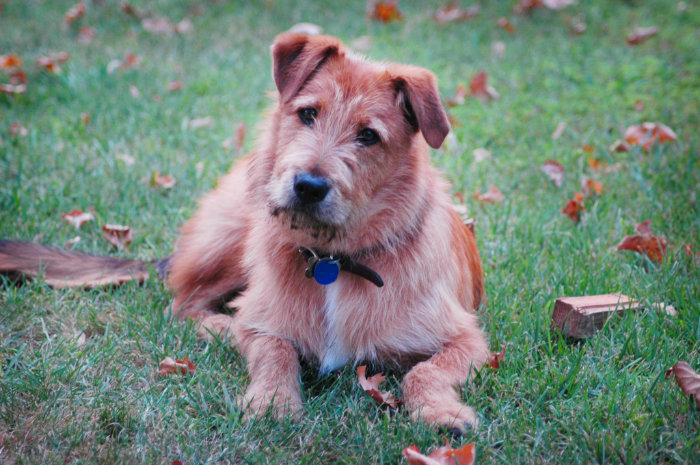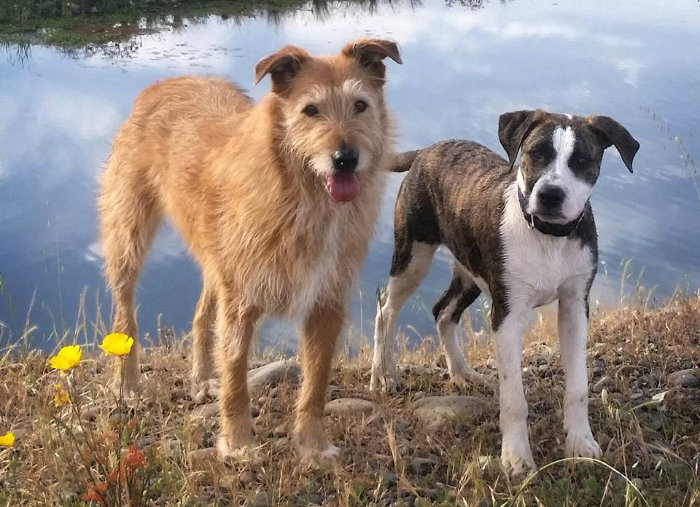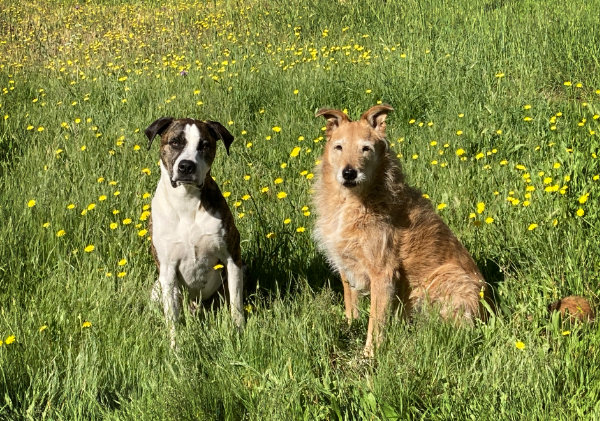Dog trainers are most likely to hear from new prospective clients when the clients’ dogs are in the throes of adolescence – and it’s easy to see why. Puppies are adorable, fun, and easy! They get tired quickly and even if they are not taking well to a forced nap in a safely confined area, their unhappy reaction never lasts long. Many puppies are so darn cute and easy to manage, that they never receive formal training beyond the very common “Sit! Sit! SIT!” (and push the puppy’s bottom to the floor)-style of training that people who don’t know better invariably put their puppies through.
Then those sweet, tractable puppies enter adolescence. They don’t get tired so easily. They learn to be more persistent about airing their grievances when confined or restrained. They develop “object permanence,” whereby they totally remember where you put that thing that you took away from them, and they work to get it back, instead of forgetting it exists, like they might have when they were toddlers. They develop opinions and interests: “Oh my dog, I LOVE squirrels! I want to go see that squirrel RIGHT NOW! Squirrels are the BEST!” They need more physical exercise and more mental stimulation and more information about what they ought to be doing with their time; lacking these things, they become inventive about entertaining themselves.
And their owners tend to freak out at these developments – as if they weren’t natural and normal!
At this point, unprepared and irresponsible (or just wildly overwhelmed) owners tend to bring those pups to a shelter, or try to rehome them on Craigslist. More responsible owners will call a trainer – although they might freak out even more when they find out that the “teen dog” training classes have been booked months in advance.
Before I went on a several-year jag of fostering large litters of puppies for my local shelter, I used to foster adolescent dogs for them. My husband and I sold the house where I used to have my office – and where I used to foster all those puppies – and our new house is nowhere near as well set up for fostering puppies; there isn’t a good place (yet) for setting up a safe, foxtail-free play yard or a place where moms and tiny puppies can be comfortable in all weather (cool in our brutally hot summers, warm in our coldish winters). So it looks like I’m back to taking on adolescent foster dogs, rather than raising puppies.
The dog I was calling Kiki was my last foster. She was the typical adolescent shelter owner-surrender: relentlessly active, curious, and smart. She had picked up a few good-manners behaviors while staying in her second adoptive home, but was too pesty to get along with the adult dog there, and got returned again. Besides the things she learned in that home, she didn’t know much; she clearly hadn’t been taught anything by the people in her first home. So, while she spent a good part of any free time she had picking up items that belong to humans and putting them in other places – such as, taking the gardening gloves off the table on the back deck, and placing one next to the fence at the back of our two acres and the other next to my car in the carport – and driving my dog Woody to near-depression with her unending pestering, she was also quite interested in working with people and learned things very quickly. Within weeks, I could take the funny little mixed-breed dog with gigantic ears on off-leash hikes and mountain bike rides, for rides in the car (she rode and waited in the car with impeccable calm), and to friends’ homes. This took a lot of work and attention, however. If we failed to get out for a fair bit of exercise each day, she’d start looking for things to occupy her time – not good things, either. She was a classic “teenager” – but I’m confident she’s going to be a terrific adult.
Kiki got placed in a great home about 8 weeks ago – and then, just two weeks later, we had a death in the family (my brother-in-law). The disruption in my schedule and tasks that I’ve taken on to help my sister have been taking up all my spare time, and I haven’t yet contacted the shelter to see if there is another dog that needs foster care and training. So it’s been about 8 weeks with only my two adult dogs here, and I have to say . . . it’s heaven. They are such an easy pleasure to be around.

Folks, it might take a year or two, but I assure you: If you stick with them, keep up the training and the exercise and the good, solid management, your crazy, impulsive, naughty adolescent dog is going to mature into the best dog ever, and the memory of those endless days of finding holes in the lawn and chewed-up shoes and gloves all over the property will fade, I promise. If I read the articles I wrote about my 13 ½-year-old dog Otto when he was an adolescent, why, I would barely recognize the issues we were dealing with then. And the worrisome behaviors that 5 ½-year-old Woody exhibited during his adolescence (namely, he went through a period of about a year where the well-socialized, formerly friendly, confident puppy turned into a fearful, growly adolescent when meeting strangers), have completely disappeared. As he matured, with a lot of counter-conditioning and desensitization, he outgrew those fears and regained his former happy, goofy confidence.
Personally, I think every puppy should come with a disclaimer: “There is likely to be a period, about six to eight months from now and lasting as long as a year or more, when you will seriously consider giving this puppy away. Please get ready and do your homework now, even when it seems completely unnecessary because this is such a good little puppy, and you will get through the puppy’s “teenage phase” with your relationship, family, and home intact.”

For more information, see these articles on teen dogs (note that the titles of the articles may be different in the print version of the magazine and the online version):
“Teen Angel,” November 2014
“Social Studies,” October 2015
“The Puppy Raising Challenge,” November 2017
“Smells Like Teen Spirit,” March 2018
“Time Flies When You Get a Puppy,” March 2017
“Fear Not!” December 2018
Did you have problems with your dog when she or he was an adolescent? How did you get through that period?







Good, interesting info. But it would be a lot more helpful if you had included an age range for what you’re calling “teenage years” for dogs.
Thanks!
It varies. Small dogs are adults by one year old and their teenage years can be short. Large dogs aren’t adults until 18 months to even 3 years so their teenage years can be longer. You need to look up the range for the size and breeds of your specific dog but that will only be an estimate. Observing behavior is better indication.
My dog, Lilly, (Aus. Shep./?) was a wild puppy. She was so bad we joked that she must have been an escapee from the African Wild Dog exhibit at the zoo, She wasn’t the first puppy I’ve had, so I new that she would settle down and become the best dog ever. I used what I call the three P’s of puppy training, patience, practice and persistence. My efforts paid off. The nabbing of discarded shoes turned into a game of “lets put the shoes away”. Stealing garden gloves from my tool bag became “fetch my gloves”. We have also done agility, taken long walks and played catch with the disc.
Although many people would have sent this dog to a shelter after a few puppy bites, it was never a consideration. Lilly is now a senior at age 14 and I value every minute we share.
Thanks for this. We just adopted a 3-4 yo from a rescue place 4 weeks ago. As we get to know each other better and as she feels safer here we are seeing her true personality…..she’s beautiful and sweet as can be….also a digger, chewer, shoe thief…AND is afraid to get in the car. We’re slowly working with her on car and recall. All in good time…..her time, not my time. I have the help of a great trainer. Fortunately I work from home now and can give her a lot of attention adn training time. My past dogs were so different so this is all brand new.
My dog is afraid of elevators. They each have their little idiosyncrasies.
Diana pawPrints is 100 lbs and will be 3 end of October. I was lucky with the timing. I started taking her to puppy classes and puppy play when she was 12 weeks and we had weekly obedience classes all through her adolescence. I also started her on scentwork at 4 months and we continued that until the pandemic hit and there were no more trials to go to. She has a clingy personality and now is more than content to nap on the bed next to me all hours of the day and all night. She does some digging in the yard when the ground is soft after a rain or if she is pursuing a mouse, but otherwise is content to amuse herself chasing birds or playing with her balls. That is, when she isn’t napping. Her only vice is to bark at the mailman from behind the side gate to the back yard when there is a delivery. At least I have a built in alarm system to let me know when an “intruder” is in the front yard. We go to the dog park but she is more interested in greeting all of the owners before she starts to play with any of the dogs. I can’t say she had any really terrible teens. She had plenty of toys, I’m retired so was at home all of the time, and when she got antsy I was always there to throw some balls, go on a walk or do a bit of training with her. She had grown to be a wonderful dog. I had hoped she would be a certified therapy dog by now but the pandemic canceled all of the CGC classes and tests. Our humane society where she took all of her classes only has classes online still. I keep checking the AKC website for local clubs but nothing there yet.
I don’t know what my circumstance will be in 10 years after she passes. I will likely have to adopt a smaller dog as I’ll be in my mid to late 70s and won’t be able to handle a 100 pounder any more. While I wouldn’t have any trouble with a puppy, if I am no longer in my house but in a senior community I will likey have to adopt an older dog that is already house trained. That may mean a “returned adolescent.” It will be my fifth dog so I think I’m up to the demands.
I had adopted my last (extremely laid-back) dog at roughly age 3-4 so she was never any trouble. As long as she got her daily walk she was perfect. She passed from cancer in 2018. In early 2019, I adopted an adorable 11 month old pup from our county shelter. No history on her, she had been a stray. What a difference! She was house trained, and knew a couple of basic commands, but that was it. Very active, could be “bitey”, easy overstimulated by play. I would have never considered returning her – she was now our responsibility! Two years later she is still not laid back like our last dog, but few dogs are. We found out she is half-Beagle and part Lab with a very high prey drive. She’s crate-trained, loves to fetch, and is gradually calming down to be the adorable adult dog she is destined to be. I started following WDJ after adopting her, and the magazine and many of the training books have been a BIG help!
Timely article as I now have one those teenagers. In February I brought home a 14 month old Brittany with no training and little socialization. Talk about a wild child!
This brought back memories! When I adopted my sheltie mix over 14 years ago she was truly a wild child that appeared to have had no training whatsoever (she had been left in a shelter overnight drop kennel). We went through several years of chewing the wrong things, separation issues, heart stopping escapes and feeling like I was walking a giant flea….to her credit, she did have great social skills. We stuck with it and eventually she matured, learned obedience….mostly…and became a wonderful companion. She is one of the sweetest dogs imaginable and, at 15+, still enjoys twice daily walks with friends…canine and human. I know her time here is getting short and I will miss her terribly but I am so glad we stuck it out through those trying teenage years.
Thank you for your article.
The part about keeping up with training, exercising and mental stimulation is so true! My 18 month old Newfoundland has just earned her 2nd trick dog title and only because she has such a drive to work she will destroy the house and drive me crazy if she doesn’t have enough to do! LOL! She is still in the throes of her teenage years and, I admit, I’m looking forward to her settling down. I want to train her to be a therapy dog, but she’s not quite ready yet.
As a trainer you would see this so clearly. Puppies did marvelously then when brought back for more training as adolescents the parents couldn’t believe how much harder it was!
When my dog, Tuck– now almost 4– was a pup, he woke up every morning full of energy. I thought I had had energetic dogs before, but he was like a little tornado on morning walks. He’d grab at sticks, at the leash, run in wild circles, leap into the air. Each walk was a sore trial. I tried playing ball with him first thing, in the pen, before we set out, but it only helped a little bit. I tried interactive breakfast dispensers. When we weren’t out hiking in the mornings, he was telling me he wanted to go out, to play, to do something– anything! It was hard to get anything done, because he wouldn’t settle. So, we trained. I contacted a trainer to help me teach him how to settle. I kept teaching him things, and as he got a little older, the wild behaviors diminished, he became more consistent about following directions, and now what is left is a smart, well-trained, energetic, happy dog. What helped me was telling myself that he would be able to use this training when he calmed down, even though he was erratic about it as an adolescent. Friends now ask me how I got him to listen so well, to come on command while off leash in the woods. And really, the answer is that he is a very bright dog, and I was feeling very desperate, so I kept training!
My husky, Fergus, is a week shy of 8 mos old. He was an obnoxious little sh*t the day we brought him home–the first thing he did was go to the dogs water bowl and sit…s-i-t…in it. We have a picture of my GSD looking at him like, “Dude, we DRINK out of that!” and Fergus was like “a husky’s gotta do what a husky’s gotta do” so we knew we were in for a wild ride with him.
He was relatively easy to housetrain, was totally trained by 5 months, and knows how to sit, lay down, shake, wait and leave it. He KNOWS how to do those things, but has entered that phase where he picks and chooses what to obey.
He’s just lucky he’s so dang cute.